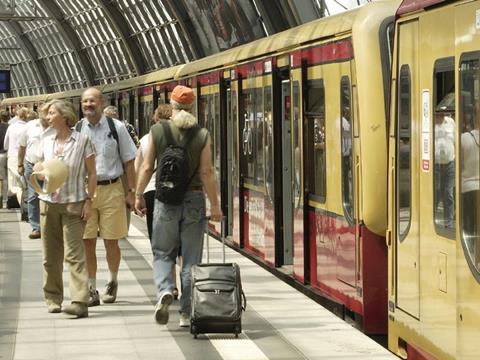
GERMANY: Passengers turning up for S-Bahn services in Berlin on July 20 were confronted with a drastically reduced timetable. S-Bahn Berlin GmbH had been forced to withdraw a huge proportion of its rolling stock fleet, leaving just 165 of its 630 two-car units operational.
Under the emergency timetable, 19 stations have no S-Bahn service at all, notably the east-west Stadtbahn between Zoo and Ostbahnhof which is partly replaced by a strengthened Regional Express service, the branch to Spandau and the line to Schönefeld Airport. Elsewhere, the intention is to provide at least a 20 min interval service on the outer routes and every 10 min on the ring.
The DB subsidiary has been battling against rolling stock shortages since May 1, when one of the Class 481 sets that form the majority of its fleet was derailed at low speed by a broken wheel. Following this incident, the operator committed to check Class 481 wheelsets for cracking on a regular basis, with a ‘four-eye’ visual inspection every seven days backed up by eddy-current testing. However the Federal Railway Office found that this regime was not being adhered to, and issued an enforcement order on June 29.
One immediate consequence was the dismissal on July 2 of the entire management team at S-Bahn Berlin (p54). Even before the accident, the company had been criticised for reducing maintenance costs by extending intervals between overhauls and reducing staff numbers. This had boosted the operating surplus, with €56m transferred to DB’s corporate accounts in 2008.
In fact, the frequency of ultrasonic wheelset examinations had been stepped up from 120 000 to 60 000 km, in November 2008, because the Class 481 axles are made from a steel with similar characteristics to the A5T steel used in the axles of ICE3 trainsets (RG 12.08 p941). S-Bahn Berlin currently has four ultrasonic test units available, and two more are being ordered.
Following strength calculations on key components, EBA issued new rules on July 16. This specified wheel life limits ranging from 650 000 km for the leading wheelset on the Class 481 driving car (position A1) and 850 000 km for the outer wheelset on the second vehicle (B1) to 1·5 million km for wheelsets on the two inner bogies. Each two-car unit averages around 150 000 km a year.
By September 30, S-Bahn Berlin must be able to undertake eddy-current inspections of the A1 and B1 wheelsets every 30 000 km, and of the others every 60 000 km. EBA also set July 20 as the deadline by which any wheelsets exceeding the new limits had to be taken out of service — hence the emergency timetable.




















